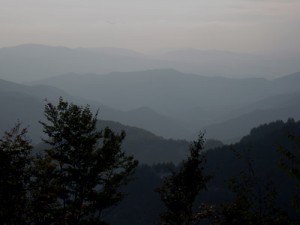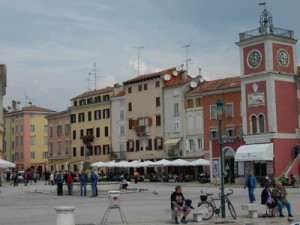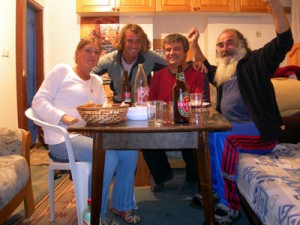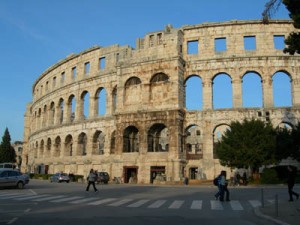Croatia

With cloudy sky and some drizzles I entered to Croatia. In route to Umag I stopped in a petrol station and when I knew Davor I was moved. He told me that his 108 year-old Croatian aunt live in Argentina, in a small town of Río Negro and only two years ago, for the first time, she had returned to Croatia to know the descendants of her family. Davor, to the knowledge that I was Argentinean, told me very moved the whole history of their ancestors while their eyes were filled with tears.
According to Davor, the Croatians, a Slavic tribe, emigrated in the century VI a.C. from the White Croatia, a region that belongs today to Ukraine, toward the lower valley of the Danube River. From there they continued toward the Adriatic Sea and they settled down in the former Roman provinces. But to long of the history the Croatians were invaded and occupied by the Byzantine Empire, for the Hungarians, the Turks, the Austrians, the French and the Germans.
It was only in the beginning of the XX century that Croatian, Serbian and Slovenian leaders organized the separation of the Austro-Hungarian Empire and the union with independent Serbia. The defeat of Austria-Hungary in the First World War accelerated the creation of the Yugoslavian Kingdom in 1918. But when beginning the Second World War, Yugoslavia was divided internally and it was dismembered easily by Hitler in 1941.
In 1945 the resistance led by Tito liberated to the country from the army occupant, and he proclaimed the Federative Popular Republic of Yugoslavia (with a communist regime) in the one that Tito exercised the power until his death; first as government boss (1945-1953), and then as president of the Republic (1953-1980). Finally in the decade of the 90, after the collapse of the communism in oriental Europe the new nations of the former Yugoslavia arise: Slovenia, Croatia, Bosnia and Herzegovina, Serbia and Crna Gora, and Macedonia but with them also the beginning of new wars.
According to Davor, today the peace reigns again, but most of their people cannot still forget.
Km 47,218

During my stay-days in Croatia I met people from different regions of the former Yugoslavia, with those of the north, for their proximity to Italy; we understood each other in Italian, and with those of the south in English. But in all of them I found a common denominator: their warmth and their simplicity; and I felt as comfortable as with the Russian, when I crossed the Baltic countries one year ago behind.
When I arrived to Porec I found difficulty to find a place to stay, due to the high flow of tourism, departments exist to rent, but any cheap alternative for the travellers without pretences. For this reason I wandered in vain more than one hour, under a strong rain and with the beginning of the night. And when I believed that I would not find place to sleep, I met Zarko who kindly allowed me to stay in one from their apartments to a very accessible price. Then his mother brought me food. And I surprised myself when in the morning following they didn’t accept me the payment, because they also wanted to contribute somehow with my trip.
Rovinj
In route to the south of Istra peninsula I arrived to Rovinj, a small town of fishermen that it mixes with a high flow of tourism, mainly Italian, Austrian and German. So I carried out some sales taking advantage of that the rain had stopped.

Later I searched information to leave the city and I stopped to ask to a man who used long hair and white beard. And I was surprised, Vito was Argentinean, but he had left from Argentina 30 years ago. He was craftsman and he had been living in Italy during many years, but today Croatia was his new house and its people his new family.
Finally the coffee and the chat that they promised to be for some minutes extended for three days, and his Croatian, Bosnian and Serbs friends became mine. Without a doubt Rovinj in spite of its rains will also be in my best memories.
On Sunday the sun shined, seven days had passed in those that rained in an uninterrupted way, and finally I could come back to the route.
Way to Split

My road to Pula continued by the coast; Croatia is a country of splendid nature, its national parks and its coasts with more than a thousand islands have become one of the innovative places for the European tourism. Once in Pula I visited the amphitheatre, one of the so many legacies of the Romans and their great empire. And on the evening I went to the camping site, where I sighted one of the most beautiful sunsets in my trip, this time was on the Adriatic Sea.
In route to Rijeka I had to face the strong wind and to cross several mountains, the cold weather which came from the Balkans range was who indicated me that I should hurry and to go as soon as possible toward the south. So in Rijeka I took a ship to Split, a city which was created from the construction of the Roman Emperor’s Palace in the year 293 a.C. Today the beauty of Split is protected by the UNESCO, and inscribed in the Cultural Registration of the World Patrimony.
And from there I left again to Italy, my destination was Ancona by ship, from where I would go toward Rome to continue in south direction.


